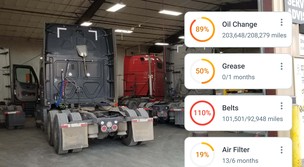As of December 2024, there are 968 fleet management software (FMS) options listed on Capterra alone. Think of going through dozens of them, hoping to find the perfect fit for your fleet. You spend days, maybe weeks, swamped by endless features and specs, sitting through overhyped demos, and feeling your brain turn to mush.
You finally make a decision, invest in the new software...and it’s a letdown. With confusing interfaces and features you’ll never use, the software feels more like a chore than a solution. Your team struggles to adopt it, productivity drops, frustration builds—and the investment starts to feel like a mistake.
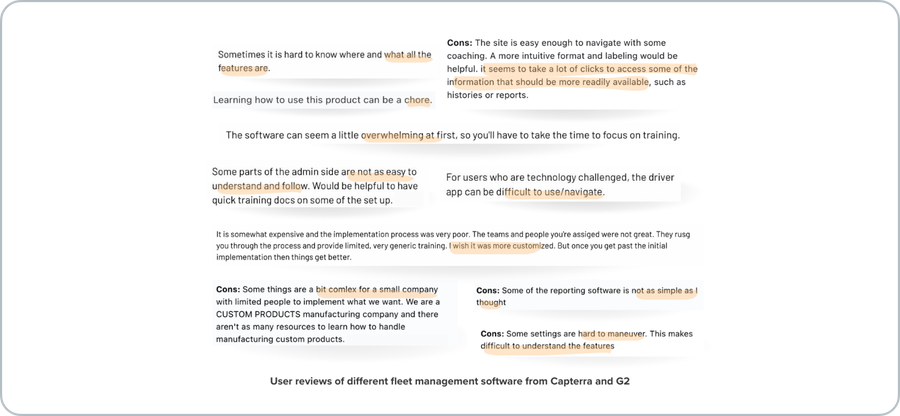
User reviews from Capterra and G2 on usability challenges and feature overload in fleet management software
Want a fleet management system that’s worth the investment—one your team will use, appreciate, and benefit from? The key is to pinpoint the essential fleet management features and your team’s challenges—all before you start shopping. Otherwise, you risk ending up with a bloated tool that looks great on paper but fails in practice.
This article helps you cut through the noise and focus on features that solve your business's real problems—not just ones that look impressive in a demo.
Let’s first break down a common misconception that trips up many software buyers.
Fleet management features: Why less is more
When evaluating fleet management software options, it’s tempting to think that more features equals better value. It feels like you’re getting more for your money, right?
Take this comment from someone evaluating FMS options:
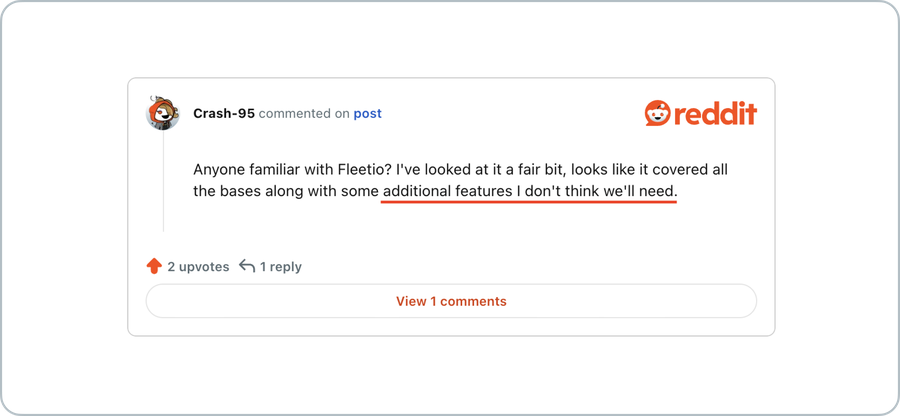
Reddit comment from a user looking into FMS options
At first glance, it might seem like a good deal: the software covers all the essentials and throws in some extras. They could come in handy later, couldn’t they? But here’s the catch: extra features often mean cluttered menus, dashboards you’ll never touch, and workflows you didn’t ask for. Instead of helping, they overwhelm your team and distract from your fleet’s core needs. You risk becoming one of those reviewers above—frustrated by a system that promised you the moon but delivered a puddle pretending to be it.
Paolo Piscatelli, the owner of Alarm Relay, shares a similar experience with us. They implemented a fleet management software with what seemed like a nice extra feature, but things went south:
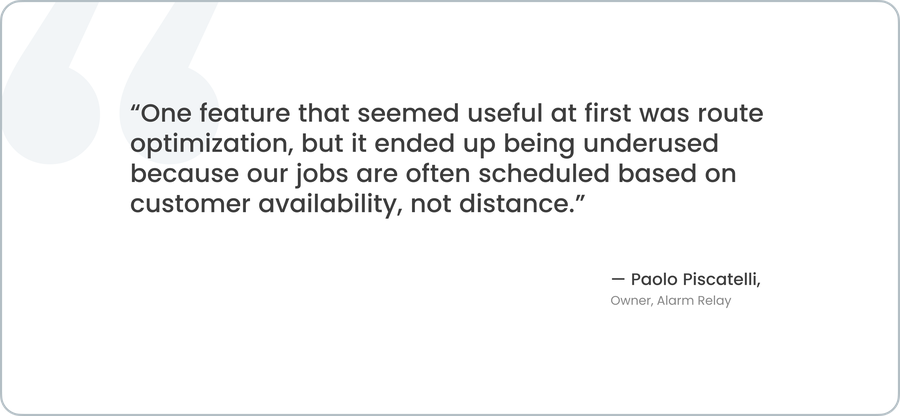
This misstep saddled Paolo’s team with a tool that collected dust and didn’t justify wasted resources.
Don’t want to waste money on software features you’ll barely use? Get clear on the core fleet management features and your fleet’s goals. Let’s start with the essentials.
What are the core fleet management system features?
Fleet management software is designed to help fleet managers address everyday challenges that are difficult—or even impossible—to handle manually. Today these challenges include preventative maintenance, ensuring safety, monitoring vehicle performance, and keeping accurate qualifications up to date, among other critical tasks:
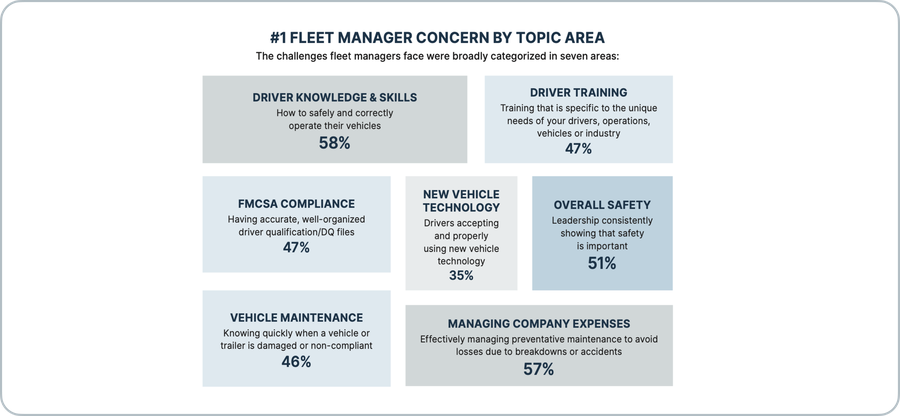
J.J. Keller and Associates 2024 study on the state of fleet management
To address these needs, efficient fleet management software must offer the functionality to:
- track vehicles in real-time, ensuring they’re on the right routes and their location is always visible. Most commonly, this feature is called real-time location tracking or GPS tracking.
- monitor how your fleet is being used—whether vehicles are moving, idle, or operational. It helps balance fleet usage by identifying overworked vehicles or underused ones. This feature is often referred to as asset utilization management, fleet performance tracking, and the like.
- schedule and track maintenance tasks to prevent breakdowns and reduce downtime. This is commonly called maintenance management or preventative maintenance. It includes alerts for issues like low fuel or engine trouble, so you can fix problems before they escalate.
- improve compliance and decrease accidents with tools like dash cams and automated safety alerts. This feature is known as safety management or driver and fleet safety.
- customize dashboards and make sure every team member sees the data they need, without unnecessary clutter. For example, dispatchers can focus on route statuses while mechanics track maintenance alerts. This is often referred to as customizable or personalized dashboards.
These features aren’t just optional add-ons—they’re what make your fleet run better, safer, and cheaper. Without them, fleet operations can become a guessing game that costs time and money.
Fleet Chaser, for example, adapts these core features to the needs of fleets with heavy and specialized equipment—in industries such as construction and landscaping. These include real-time tracking for expensive machinery or maintenance management designed for the tough conditions of job sites, among others. Fleet Chaser’s drag-and-drop widgets let business users create dashboards that work for their specific roles. Safety managers can track incident reports, while field operators monitor real-time location data for heavy equipment—all in one streamlined interface.
No matter your industry, be it construction or any other, those five core features are the foundation of any reliable fleet management system. They address the daily challenges without overwhelming the business user.
So, does that mean you just check for these features in the software and move on? No, sir. The next stage is to pinpoint your fleet’s unique priorities and challenges, then get specific about what your fleet management software must deliver. In other words, go beyond the basics.
How to choose the best vehicle tracking system features for your team
The goal of this section is to help you enter demos or customer service discussions with a clear understanding of what you need from your fleet management software—making it easy to eliminate vendors that don’t fit.
Technologist Scott Brinker shared a timeless tip from his colleague:
“Write down specific scenarios for things you want to do with the software. Map it out, so when you get into the demo you can ask the salesperson, ‘Can you walk us through this scenario?’ Evaluate several vendors through this same objective lens. It’s not just about what features they have, but how would those features work in practice for our organization?”
How do you find these scenarios? Here are four steps to guide you:
- Define—or refine—your KPIs. Start with the outcomes you want, like reducing downtime or improving safety. Use these to shape your KPIs.
- Involve your team. Get input from those who’ll use the system daily. Understand their pain points and feature priorities.
- Create a feature matrix. Sort features into must-haves, nice-to-haves, and irrelevant to stay focused and objective.
- Consider industry-specific options. Prioritize tools built for your field—construction, logistics, or otherwise—to address unique challenges.
Define—or refine—your KPIs
Fleet managers have to juggle cutting costs, keeping drivers safe, staying compliant, and satisfying customers—all while racing against the clock. It’s a lot to handle, and without a clear plan, it’s easy to feel like you’re just putting out fires.
Key performance indicators (KPIs) are irreplaceable here. They help you see what’s working, what’s not, and show your organization the value your fleet delivers.
A good rule of thumb: work backward. Start with the outcome you want, then define a KPI to measure progress. For example:
- Outcome: Reduce vehicle downtime by 20%.
- KPI: Track the percentage of preventive maintenance tasks completed on schedule.
Align your KPIs with broader business goals. Erin Gilchrist, an award-winning fleet leader, suggests focusing on these six critical areas:
- Fleet safety and driver behavior
- Number of accidents per million miles
- Accident costs (damage, injury, and related expenses)
- Driver safety scores (aggressive or distracted driving incidents)
- Compliance
- Regulatory adherence (DOT compliance, digital inspections, certifications)
- Driver qualification metrics (training, medical exams)
- Fuel management
- Fuel efficiency (MPG per vehicle, driver, or region)
- Total fuel consumption and cost per gallon
- Fuel fraud percentages
- Maintenance
- Vehicle downtime
- Preventive maintenance (PM) compliance
- Maintenance cost per mile or event
- Fleet cost
- Total cost of ownership (TCO)
- Fleet cost per mile or unit delivered
- Budget performance and year-over-year cost comparisons
- Vehicle lifecycle
- Vehicle performance trends (safety ratings, fuel economy, maintenance history)
- Replacement cycles and aging vehicle costs
If you already track KPIs, use this list to identify gaps. Could these areas improve your operations? If you’re starting from scratch, focus on these essentials.
Also, make your KPIs SMART: Specific, Measurable, Achievable, Relevant, and Time-bound. For example, instead of “track vehicle maintenance,” write “achieve 90% preventive maintenance compliance by Q2 2024.”
In the end, make sure everyone on your team knows the KPIs and sees how their work connects to the bigger picture. When people understand the impact of their efforts, it sparks accountability and turns individual tasks into a shared mission that drives the fleet forward.
Speaking of your team…
Involve your team early
If your team doesn’t embrace the new system, the investment will fail. Plain and simple. Change is never easy, and fleet management teams know this all too well. Over the years, they’ve had to adapt to new technologies, stricter regulations, and new workflows, whether it’s telematics, advanced driver assistance systems (ADAS), or automated processes in the back office.
To make the transition to a new fleet management solution smoother, involve the people who will use this software daily (managers, drivers, mechanics, dispatchers) early in the process. Here’s how:
- Hold workshops. Get direct input from your team. What are their biggest pain points? What features would make their jobs easier?
- Communicate the Why. Explain the purpose behind the change. Are you aiming to reduce manual tasks, improve safety, or minimize downtime? Show how the new fleet management system will benefit the fleet team.
- Highlight role-specific benefits. For example, show dispatchers how real-time tracking improves routing efficiency, or mechanics how automated maintenance reminders make scheduling simple.
- Spend time watching how your team operates. Ride along with drivers to identify inefficiencies, observe mechanics tracking maintenance manually, and sit with dispatchers as they juggle schedules.
- Address potential concerns and resistance. Change often comes with apprehension. Usually it’s fear of learning new technology. Acknowledge these concerns openly and reassure your team that the system is meant to support their work.
Get your team on board early and show them exactly how the fleet management system will make their lives easier. When your team feels heard and sees the value, they’re more likely to embrace the change—and turn the software into an effective tool, not another headache.
Create a feature matrix
Picking fleet management software can feel like throwing darts blindfolded. A feature matrix is how you stop wasting time on systems you’ll regret later.
Here’s an example of how one looks:
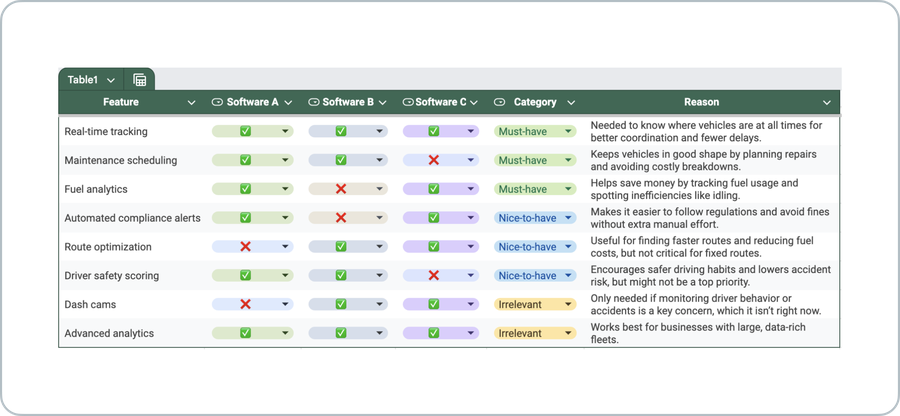
And here’s how to create one that works for your team.
Step 1. Research FMS options
Start by listing potential vendors and noting the fleet management features they offer. Don’t just skim over the names—dig into what each feature actually does. Common examples include:
- Real-time tracking
- Maintenance scheduling
- Fuel analytics
- Telematics
- Route optimization
- Dash cams
Step 2. Categorize features
Sort these features into three categories based on your business needs:
- Must-have: critical features that address your top challenges, like staying compliant or cutting downtime. Example: maintenance scheduling and alerts, IFTA reporting automation.
- Nice-to-have: features that add value but don’t take priority. Example: fleet analytics.
- Irrelevant: features that don’t align with your fleet operations or offer little to no return on investment. Example: advanced route optimization for fleets that operate on fixed routes.
Step 3: Evaluate against KPIs
Look at your most important KPIs and check whether the must-have features align with them. If a feature doesn’t directly support a key goal, it’s not essential.
For instance, if your priority KPI is increasing vehicle uptime, focus on features like real-time tracking and predictive fleet maintenance. Write them down and be sure to ask for detailed demos, check case studies, and read user reviews later to see how these features actually work.
Step 4. Use a visual template
Organize your findings in a table for easy comparisons. Break it down by software option and mark whether it includes your must-have, nice-to-have, or irrelevant features.
You can use a spreadsheet, as shown earlier in this section, or go for a more detailed software comparison template like this one:
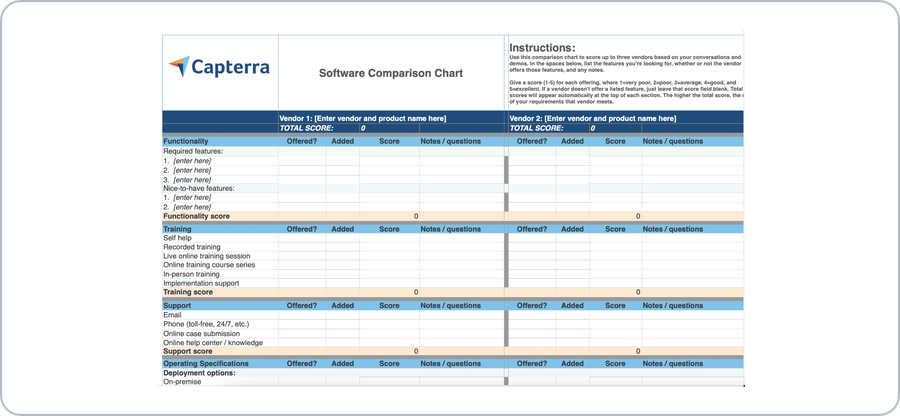
Software comparison template from Capterra
Step 5. Score and compare
Assign scores to each software based on how many must-have features they meet. Prioritize fleet management systems that check all your critical boxes without overwhelming your team with unnecessary complexity.
Consider industry-specific options
Not all fleet management software is built with your unique challenges in mind. Sure, some tools promise to “do it all,” but when trying to fit everyone—they fit no one. So why get a Swiss Army knife when what you really need is a hammer that hits the nail every time?
If you’re in construction, logistics, home services, and other industries, you don’t need a one-size-fits-all solution. You need software that understands your field and doesn’t overwhelm you with features you’ll never use.
Examples of industry-specific features:
- Construction: asset utilization and maintenance tracking to ensure heavy equipment is where it needs to be and in working condition.
- Logistics: route optimization and regulatory compliance tools to avoid delays, fines, and inefficiencies.
- Home services: scheduling and real-time communication to keep appointments on time and customers happy.
- E-commerce: real-time tracking and automated delivery notifications for smooth operations and satisfied customers.
So when evaluating FMS options:
- look for case studies or testimonials to check if the software has a proven track record with businesses like yours
- ask about niche features; for example, geofencing for construction to keep equipment on-site or advanced route planning for logistics to streamline deliveries
- prioritize tools that directly address your daily pain points
An industry example: Fleet Chaser for construction, landscaping, and service industries
Fleet Chaser helps businesses that rely on heavy and specialized equipment. Our fleet management software solution focuses on the core needs of industries like construction, landscaping, and services such as roofing and plumbing—making sure equipment is on-site, operational, and safe for your team. Here’s how it delivers:
- Customizable real-time map
Track vehicles and equipment in real-time. Filter by status (working, idling, parked) and add layers like traffic or weather to plan efficiently.
- Dash cam integration
Monitor live footage of drivers and the road. Use alerts to address drowsiness, resolve accidents quickly, and improve overall safety.
- Personalized dashboards
Let dispatchers, safety managers, and mechanics customize dashboards to see only the data they need—no clutter, no confusion.
- Automated reporting
Generate reports for IFTA, state mileage, work hours, and maintenance logs—saving time, reducing errors, and simplifying compliance.
- Automated notifications
Set up alerts for engine failures, idling, or maintenance needs. Address problems instantly and avoid costly downtime.
By choosing industry-specific fleet management software, you cut through the nonsense. No more “what the heck is this for?” moments. Just tools that solve your actual problems—so you can focus on getting the job done.
Recap: How to define the right fleet tracking features?
You don’t need every shiny feature to manage your fleet. What you do need is a system designed to tackle the real challenges your team faces: reducing downtime, cutting costs, improving safety, and streamlining fleet operations. It’s about finding tools that work for your team, not flashy extras that end up collecting digital dust.
Let’s summarize on how to focus on what really matters:
- Avoid the oversized promises some vendors make. Overloaded systems frustrate your team, waste time, and slow down productivity. Keep it simple.
- Get serious about your KPIs. Want to slash downtime or fuel costs? Focus on software that aligns with measurable goals.
- Don’t leave your team in the dark. If your team doesn’t embrace the new fleet management system, it’s a flop. Involve them early, get their feedback, and ensure the tools work for them, not against them.
- Use a feature matrix—or risk regret. Be objective. Categorize features into must-haves, nice-to-haves, and irrelevant fluff. Without a clear comparison, you’ll end up with tools that don’t deliver.
- Say NO to generic solutions. Your business isn’t one-size-fits-all, so why settle for software that tries to do it? Choose something built for your industry, whether that’s construction, logistics, or home services.
Define your needs. Tune out the distractions. Walk into that demo with a crystal-clear understanding of what your FMS must deliver, not with someone else’s vision of what you should need.
This is about your team, your goals, and your success. Anything less? Pure noise.

















![[Fleet Chaser] Fleet Management Software Features](https://cms-media.fleetchaser.com/images/Fleet_Chaser_Fleet_Mana.format-jpeg.width-640.height-590.jpg)


